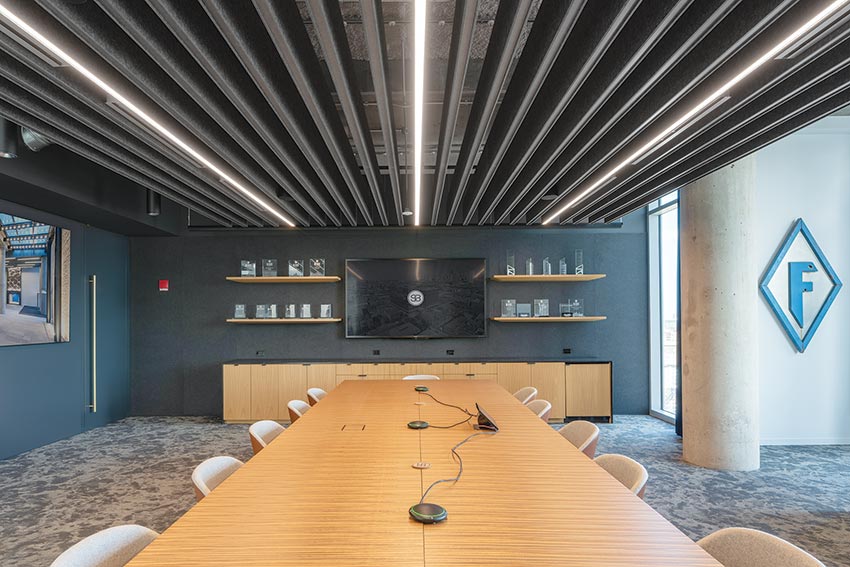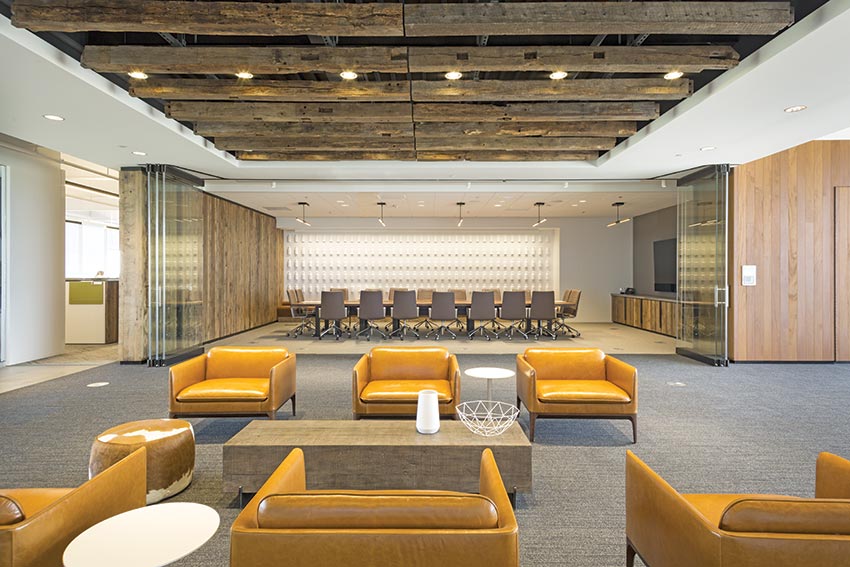Modern Acoustic Solutions for Interior Environments
With many new interiors leaning toward open spaces with high ceilings, often with cement walls or other minimalist features, noise quickly becomes a challenge. These noisy environments can be tempered with acoustic solutions that include a combination of ceiling panels and acoustic walls, although some spaces may require only ceiling systems. Of the available systems, modular acoustic ceiling panels or tiles are one of the most widely used, effective, and affordable acoustic solutions on the market, in part because of their versatility and modern design aesthetics. Ceiling panels can be made from a range of materials and in different designs. Some common materials include stone wool, cementitious wood fiber, and drywall (often referred to as gypsum board, plaster board, or sheetrock). However some projects, such as performance halls, use special wood paneling for both ceilings and walls.

Photo courtesy of PABCO Gypsum
Sound-reducing gypsum drywall can be installed exactly like standard drywall.
In addition to traditional ceiling tiles or panels, baffles and luminaires provide a more aesthetically interesting option for sound and noise management. As with tiles or panels, they can be made from different materials, including textiles such as polyester.

Photo courtesy of USG
Acoustical drywall ceilings are installed like drywall and sprayed to have a monolithic look.
Of the many available materials for ceiling panels, stone wool panels with suspension grids and accessories can be used to absorb sound in order to create comfortable and productive office spaces, quiet and private health-care suites, cinema theater interiors, and overall aesthetically beautiful interiors.
Acoustic ceilings and wall panels come in many different materials, shapes, and sizes, including cementitious wood fiber, which adds both sustainability and thermal insulation to product characteristics. These easy-to-install panels can be used in any venue where cost-effective acoustic products are specified.
Yet other projects, such as hotels or health-care facilities, require an affordable, easy-to-install solution, such as sound-reducing, gypsum drywall that can be installed exactly like standard drywall while also providing exceptional sound-transmission management. Benjamin Shafer, a technical services manager of acoustic systems at PABCO Gypsum, notes that “sound-damping drywall is an effective and efficient way to achieve high sound-isolation performance without sacrificing valuable floor space.”

Photo courtesy of Focal Point
Integrated acoustic lighting and baffle systems can manage sound in a room and improve the overall indoor experience.
Alternatively, seamless, sound-absorbing acoustic plasters, thin perforated gypsum board, and sprays can provide affordable solutions. With these options, architects and designers can easily integrate sustainable, sound-absorbing products into their projects. Another cost-effective and high-performance option includes acoustical drywall ceiling and wall solutions. These new breakthrough acoustical systems are installed and finished similar to drywall but provide excellent acoustics with a smooth, monolithic look. Custom colors, direct-mount ceiling and wall system options are also available.
Finally, other acoustic solutions can do double-duty to control sound, all while supplementing the daylighting of the space, thus making the indoor environment lighter, brighter, and quieter, all of which can help improve how occupants work and learn. Acoustic luminaire and baffle systems can easily be integrated into a space to provide sustainable sound absorption that works to improve the comfort and indoor experience of occupants of commercial spaces.
Specialty Walls and Door Assemblies
While ceiling and wall solutions can be used for the majority of projects, some spaces simply require a different take on acoustics, such as interiors with versatile, dynamic rooms that can be used for different purposes throughout the day. Such spaces benefit from nontransitional design solutions to manage acoustics. Doors and door assemblies are another important consideration in an interior’s acoustic management system; a perfectly designed interior space without an equally well-considered door system can translate to intrusive sound coming into or out of the room, and more or less undo all of the other work.

Photo courtesy of NanaWall
The Dairy Farmers of America’s new headquarters features acoustic glass walls that offer privacy from sound all while maintaining a bright, light, open space.
Some spaces don’t require acoustic support all of the time, and instead can benefit from acoustic barriers that can be folded away when they are not needed. Libraries and offices, for example, now frequently have flexible meeting spaces that can be either open or closed off with sliding glass walls. These designs can also be used in VIP rooms of event venues, allowing guests to see the event within the quiet privacy of their own space.
Acoustic openings such as doors are referred to as assemblies, which include the door, doorframe, and seal system (perimeter seal, door bottom, threshold, and astragal at paired openings). The acoustic quality of door assemblies plays an important role both in blocking unwanted noise from entering a space and containing sound so that it does not cause unwanted noise in public spaces. These assemblies also contribute to the quality of the sound within a space. These functions are critical for not only performance halls but also hospitals and schools, whether occupants need quiet for their recovery or learning. Acoustic doors and steel doorframes can also provide rated fire control.
Notice

www.ambico.com

www.acousticalsurfaces.com/envirocoustic-woodwool

www.focalpointlights.com

www.nanawall.com/hsw

www.quietrock.com

www.pyrok.com











